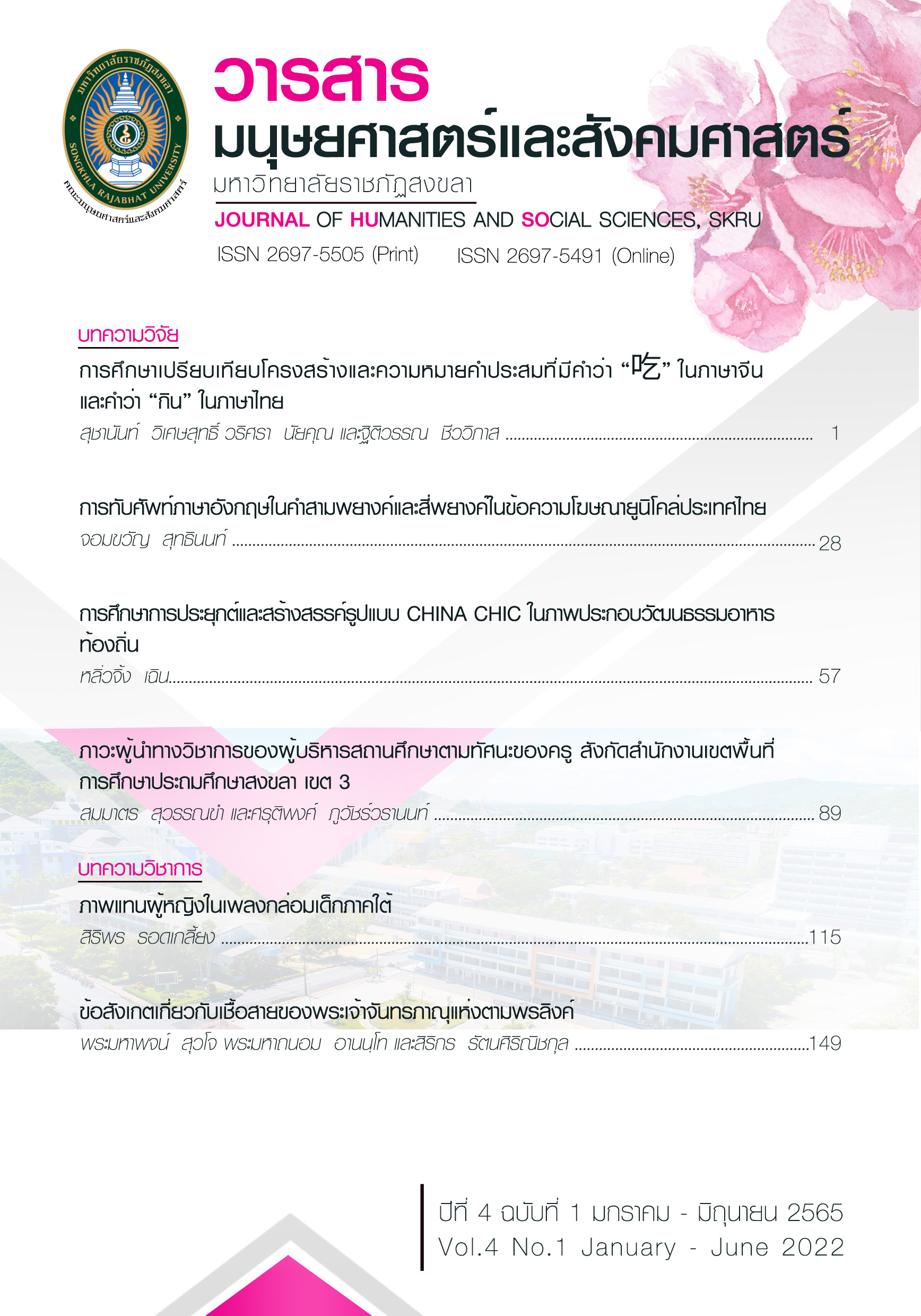A COMPARATIVE STUDY OF THE STRUCTURE AND MEANING OF COMPOUND WORDS CONTAINING THE WORD “CHI” IN CHINESE AND “EAT” IN THAI
Main Article Content
Abstract
The purpose of this research paper was to compare the meaning and structure of compound words with “吃” in Chinese and “eat” in Thai because “吃” and “eat” have meanings. the basics are the same but when combined with other words expand the meaning which is often inconsistent with the original meaning This makes in some situations those who are studying compound words in Chinese and Thai language confused and misunderstood. Therefore, this research paper analyzes the common and different characteristics of both languages. By collecting vocabulary from a Chinese dictionary containing the word “吃”, 11 extended meanings were found, and a vocabulary from a Thai dictionary containing the word “eat” found 15 expanded meanings. Research has compiled the terminology. Methods of word formation, structure, meaning and example sentences. to reflect the similarities and differences of the two languages The researcher hopes that this research paper will be useful to those who are interested and those who are studying compound words in Chinese and Thai.
Downloads
Article Details

This work is licensed under a Creative Commons Attribution-NonCommercial-NoDerivatives 4.0 International License.
ลิขสิทธิ
References
กณิกนันต์ โยธานะ. (2556). “การศึกษาเปรียบเทียบสำนวนจีนที่มีคำว่า “chī” กับสำนวนไทยที่มีคำว่า “กิน”. วารสารจีนศึกษา. 6(6), น. 145-181.
จิ้ง เสิ่น, เมธาวี ยุทธพงษ์ธาดา, และรุจิรา เส้งเนตร. (2562).
“การเปรียบเทียบการขยายความหมายของคำว่า “กิน” ในคำประสมที่เป็นรูปแบบ กริยา+กรรม ในภาษาไทยและภาษาจีน”. มนุษยสังคมสาร. 17(1), น. 67-83.
ชัชวดี ศรลัมพ์. (2548). “อุปลักษณ์ตามแนวคิดของทฤษฎีภาษาศาสตร์
ปริชาน”. วารสารศิลปศาสตร์. 5(1), น. 1-16.
ราชบัณฑิตยสถาน. (2552). พจนานุกรมคำใหม่ เล่ม 2 ฉบับราชบัณฑิตยสถาน. กรุงเทพฯ: ยูเนียนอุลตร้าไวโอเร็ต.
ราชบัณฑิตยสถาน. (2553). พจนานุกรมคำใหม่ เล่ม 1 ฉบับราชบัณฑิตยสถาน. (พิมพ์ครั้งที่ 2). กรุงเทพฯ: ธนาเพรส.
ราชบัณฑิตยสถาน. (2554). พจนานุกรมคำใหม่ เล่ม 3 ฉบับราชบัณฑิตยสถาน. กรุงเทพฯ: ยูเนียนอุลตร้าไวโอเร็ต.
ราชบัณฑิตยสถาน. (2556). พจนานุกรม ฉบับราชบัณฑิตยสถาน พ.ศ. 2554. (พิมพ์ครั้งที่ 2). กรุงเทพฯ: ศิริวัฒนาอินเตอร์พริ้นท์.
สันติ อ้ายเจริญ. (2560). “กระบวนการสร้างคำประสมในภาษาไทย-จีนบนพื้นฐานแนวคิดของ Jerome L. Packard”. วารสารบัณฑิตวิจัย. 8(2), 119-128.
สำนักพิมพ์มติชน. (2547). พจนานุกรม ฉบับมติชน. กรุงเทพฯ: โรงพิมพ์มติชนปากเกร็ด.
CCL语料库. (ม.ป.ป.). สืบค้นคำว่า “吃 chī”. สืบค้นเมื่อ 20 พฤษภาคม 2564, จาก http://ccl.pku.edu.cn:8080/ccl_corpus/
Longdo dict. (ม.ป.ป.). สืบค้นคำว่า “กิน”. สืบค้นเมื่อ 25 พฤษภาคม 2564, จาก https://dict.longdo.com/
Quword趣词. (ม.ป.ป.). สืบค้นคำว่า “吃 chī”. สืบค้นเมื่อ 18 พฤษภาคม 2564, จาก https://www.quword.com/
漢語詞典zdict.net. (ม.ป.ป.). สืบค้นคำว่า “吃 chī”. สืบค้นเมื่อ 20 พฤษภาคม 2564, จาก https://www.zdic.net/zd/bs/
现代汉语词典. (ม.ป.ป.). สืบค้นคำว่า “吃 chī”. สืบค้นเมื่อ 1 มิถุนายน 2564, จาก http://www.hydcd.com/
Lakoff, G. (1987). Women, Fire, and Dangerous Things: What Categories Reveal about the Mind. Chicago: The University of Chicago Press.
Lakoff, G. & Johnson, M. (1980). Metaphor We Live By. Chicago: Chicago University Press.
Packard, J. L. (2004). The Morphology of Chinese: A Linguistic and Cognitive Approach. New York: Cambridge University Press.
.Ungerer, F., & Schmid, H. J. (1996). An Introduction to Cognitive Linguistics. Longman.


